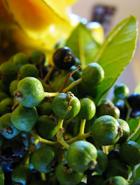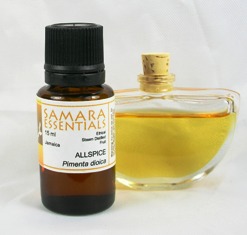
Plant Part: Fruit
Extraction: Steam Distilled
Growing Practice: Ethical
Country of Origin: Jamaica
Odor Type: SPICY

Odor Characteristic: Allspice odor can be described as spicy, warm and sweet with clove/nutmeg/cinnamon overtures. Indeed, its name is likened to these three aromatic spices. Spice notes often define the overall fragrance character, imparting warm richness. Its common name, Allspice, refers to its combination of cloves, cinnamon, pepper and juniper berry odors, with cloves dominating.
Refractive Index: 1.533
Specific Gravity: 1.033
Appearance: colorless yellow or reddish liquid
BioChemical Class: Phenol
BioChemicals: eugenol, eugenol methyl ether, and terpenes (myrcene, 1,8-cineol and α-phellandrene)
CAS No: 8006-77-7
INCI Name: PIMENTA OFFICINALIS FRUIT OIL
About the Plant
Pimenta dioica is a small to medium sized evergreen tree that grows to 40ft, needing near-tropical conditions to survive. Mature trees will stand only short periods of light frost, to 26°F. Native from southern Mexico through Central America and the Caribbean, allspice is grown commercially in Central America. Jamaica is the primary exporter of Allspice herb, as well as the essential oil, however production also occurs in the USA, UK and other European countries.Allspice (Pimenta dioica) comes from the Family Myrtaceae, a family of 3000 woody species, most of which grow in the tropics or in Australia. Essential oils from this family are rich in terpenoids. The genus name Pimenta comes from Spanish pimienta for black pepper; the species name dioica indicates that their male and female flowers grow on different plants; botanists call such plants dioecious. Allspice, however, is not a perfect example of a dioecious plant, because male trees may bear a small number of hermaphrodic flowers which develop into fruits.
The fruits (picked when green and dried on mats, added to green fruits) are the part distilled for essential oil. The fruits contain 2 to 5% essential oil (the exact content depends much on the time of harvest). As main components, eugenol, eugenol methyl ether, and terpenes (myrcene, 1,8-cineol and α-phellandrene) have been reported.
In allspice fruits from Jamaica, eugenol (65% to 90%) is the main constituent; methyl eugenol is found in minor (10%) and myrcene in trace amounts (1%). Allspice from Mexico is dominated by methyl eugenol (50 to 60%) with smaller amounts of myrcene (15%) and eugenol (10%).
History
Allspice became known in Europe long after it was first discovered by an expedition of Columbus. Because of the shape (similar to pepper corns), the new grains were termed "pepper". Often referred to as "flavor pepper", "aromatic pepper" or "condiment pepper" and similarly "Jamaican pepper", depending on the importers of the various countries in Europe. Still, they are called "pepper" in many languages, mostly with an attribute indicating their Caribbean origin or their aromatic scent.Perfumery: Allspice is considered a middle note and blends well with a number of aromatic components, including florals, citrus and other spices such as ginger.![]()
The information provided on these pages is not a substitute for necessary medical care, nor intended as medical advice. Always keep aromatic extracts tightly closed and in a cool, dark place, out of reach of children. Never ingest aromatic extracts. Always dilute aromatic extracts when applying topically and avoid areas around eyes or mucous membranes. If redness or irritation occurs, stop using immediately and contact your health provider if necessary.![]()
all images and content copyright ©2000—2020 by suzumebachi design and samara botane





